
Karl Friedrich Schinkel was a Prussian architect, city planner and painter who also designed furniture and stage sets. Schinkel was one of the most prominent architects of Germany and designed both Neoclassical and neo-Gothic buildings. His most famous buildings are found in and around Berlin.
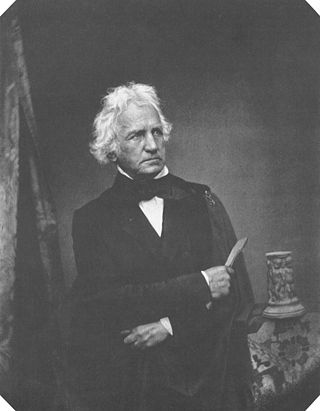
Christian Daniel Rauch was a German sculptor. He founded the Berlin school of sculpture, and was the foremost German sculptor of the 19th century.
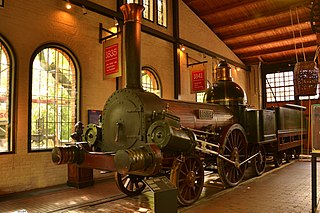
BEUTH was a 2-2-2 steam locomotive manufactured by Borsig in 1843 and was the first steam locomotive developed independently in Germany. Borsig had previously built locomotives based on American models. The locomotive won a race against a model by Stephenson by about ten minutes and was considered the prototype of fast German locomotive designs for the next ten years. A driving axle and two running axles as well as a vertical boiler ensured comparatively high speeds. It was named after the head of the Prussian trade academy Christian Peter Wilhelm Beuth, who had prophesied to August Borsig that nothing would ever come of it. A replica of the locomotive is currently on display in the German Museum of Technology in Berlin.
Joseph Caspar was a Swiss painter and engraver.

The National Kaiser Wilhelm Monument (Kaiser-Wilhelm-Nationaldenkmal) was a memorial structure in Berlin dedicated to Wilhelm I, first Emperor of Imperial Germany. It stood in front of the Berlin Palace from 1897 to 1950, when both structures were demolished by the German Democratic Republic (GDR) government.
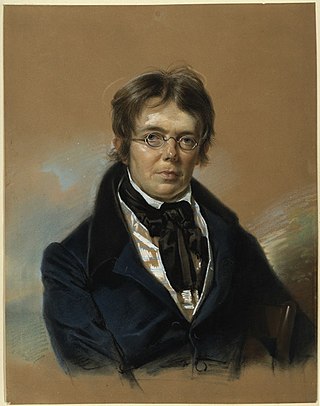
Christian Peter Wilhelm Friedrich Beuth was a Prussian statesman, involved in the Prussian reforms and the main mover in Prussia's industrial renewal.
The Berliner Hochschule für Technik (BHT) is the second largest University of Applied Sciences in Berlin, Germany. There are around 12 000 students studying at BHT in more than 70 majors and 795 employees, under which there are 291 professors and 43 guest lecturers.

Peter Christian Breuer was a German sculptor.
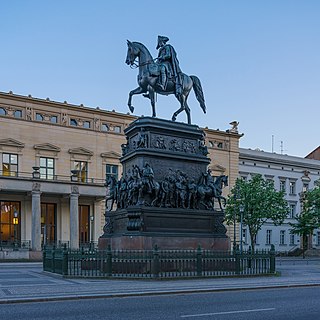
The equestrian statue of Frederick the Great on Unter den Linden avenue in Berlin's Mitte district commemorates King Frederick II of Prussia. Created from 1839 to 1851 by Christian Daniel Rauch, it is a masterpiece of the Berlin school of sculpture, marking the transition from neoclassicism to realism. The bronze statue shows "The Old Fritz" dressed in military uniform, ermine coat and tricorne hat on horseback above the leading generals, statesmen, artists and scientist of his time. Walled in during World War II, it was disassembled by East Germany in 1950, reassembled in Sanssouci Park in 1963, and returned to its original location in 1980.

The Wilhelm von Humboldt Memorial to the left of the Humboldt University main building on Unter den Linden avenue in Berlin's Mitte district commemorates the Prussian polymath and education reformer Wilhelm von Humboldt (1767–1835). Created in 1882 by Paul Otto in neo-baroque style, the marble statue is a masterpiece of the Berlin school of sculpture.

The equestrian statue of Frederick William IV is an 1875–86 sculpture of Frederick William IV of Prussia by Alexander Calandrelli, installed in front of the Alte Nationalgalerie in Berlin, Germany.
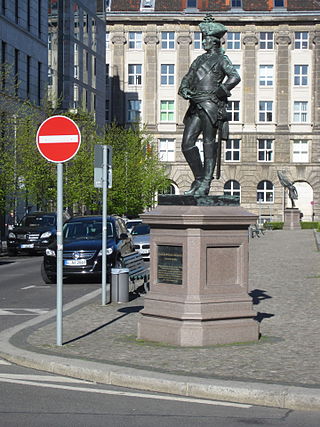
The statue of Friedrich Wilhelm von Seydlitz is a bronze sculpture installed at Zietenplatz in Berlin, Germany.

The statue of James Francis Edward Keith is a bronze sculpture installed at Zietenplatz in Berlin, Germany.

The statue of Albrecht Thaer is a bronze sculpture installed at Schinkelplatz in Berlin, Germany.

Schinkelplatz is a square in Berlin, Germany, named after Karl Friedrich Schinkel.

The statue of Karl Friedrich Schinkel is a bronze sculpture installed at Schinkelplatz in Berlin, Germany.
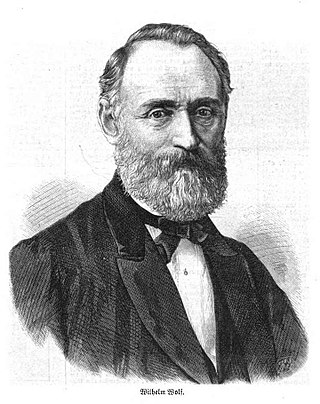
Friedrich Wilhelm Wolff was a German sculptor and journalist who specialized in the depiction of animals in metal giving him the nickname of "Tier-Wolff".

The Bülow Memorial on Unter den Linden avenue in Berlin's Mitte district commemorates the Prussian army general and freedom fighter Friedrich Wilhelm Bülow von Dennewitz (1755–1816). Created from 1819 to 1822 by Christian Daniel Rauch in neoclassical style, it is a masterpiece of the Berlin school of sculpture.

















